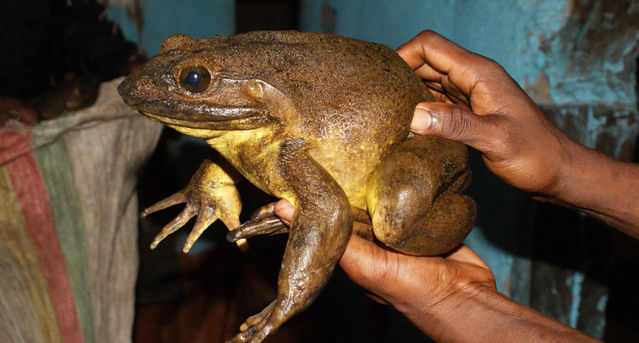Sex
Giant Frogs Are Attentive Parents
Goliath frogs make and watch over nurseries for their tadpoles.
Posted August 12, 2019

Researchers describe the first example of nest-building in an African amphibian, the Goliath frog, and suggest why they grow so gigantic in a new article in the Journal of Natural History.
For such a huge amphibian, very little is known about the biology of the Goliath frog (Conraua goliath). The largest living frog, Goliath frogs can weigh more than 7 lbs (3.3 kg) and their bodies can reach over 13.4 inches (34 cm), not including their legs. They live only in Cameroon and Equatorial Guinea in West Africa and their numbers have recently declined due to overhunting and deforestation.
Mark-Oliver Rödel of the Berlin Museum of Natural History was considering setting up a breeding program for Goliath frogs. In the course of researching requirements for Goliath tadpoles, Rödel and colleagues learned about the nest-building from local frog hunters, who trap adults for bushmeat. They decided to investigate.
Rödel and colleagues scoured the banks of the Mpoula River in West Cameroon for Goliath frog breeding sites. At first, they could only identify them by the presence of eggs or tadpoles. But soon they learned to spot detritus excavated and piled up in a way that defied the effects of the water current.
The scientists found that Goliath frogs create three different types of nest. For the simplest type, they clear naturally occurring rock pools of leaf litter and debris. For the second type, they dig out leaf litter and gravel to enlarge shallow pools and push the material to the edges, forming a dam. And to make the third type, frogs dig depressions into the riverbank and move large stones to the edge to create small, circular ponds.
“We think there is a trade-off between the energy you need to invest in creating or using a particular pond type and the chances for the offspring to survive,” says Rödel. “Each of the three nest types has advantages and disadvantages and the frogs need to choose what is best at certain times and under certain circumstances.”
For instance, the first type of nest is the easiest to construct, but least reliable, as spilling over of these nests occurred frequently. And that could bring the eggs or tadpoles into contact with predators.
Rödel and his colleagues set up a camera trap at the nest which showed the most recent signs of activity. The footage revealed a large frog of unknown sex sitting near the nest from shortly after nightfall until dawn. Rödel says that this could indicate a parent guarding its tadpoles or defending its breeding territory against other frogs.
The scientists were unable to determine which sex was responsible for building nests and which for guarding them, although one local frog hunter reported that males complete the construction while females are the guards. They didn’t directly observe the cleaning or digging behavior of Goliath frogs, but based their interpretation on indirect clues (like the excavated detritus and the structure of the nests) and information from frog hunters and local villagers.
Rödel and colleagues say this behavior may provide an explanation for why Goliath frogs have become the largest frog in the world. Digging out a nest that exceeds 3.3 ft (1 m) in diameter and 4 inches (10 cm) in depth is a challenging physical task. The scientists observed nests where stones as large as 4.4 lbs (2 kg) had been moved to the edges. Construction of such nests could only be achieved by fairly large and strong animals, possibly explaining why gigantism evolved in these frogs.
“The fact that we’ve only just discovered these behaviors shows how little we know about even some of the most spectacular creatures on our planet,” Rödel said in a statement. “We hope that our findings, combined with further ongoing research, will improve our understanding of the needs of the Goliath frog so we can help support its continued survival.”
References
Marvin Schäfer, Sedrick Junior Tsekané, F. Arnaud M. Tchassem, Sanja Drakulić, Marina Kameni, Nono L. Gonwouo & Mark-Oliver Rödel (2019) Goliath frogs build nests for spawning – the reason for their gigantism?, Journal of Natural History, 53:21-22, 1263-1276, DOI: 10.1080/00222933.2019.1642528


